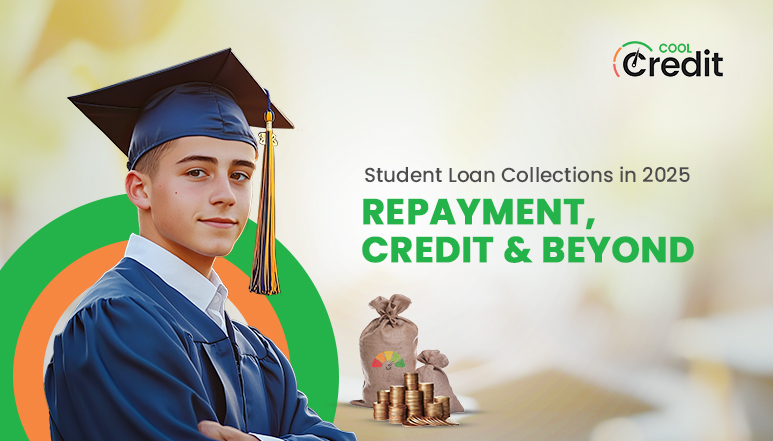
Student Loan Collections in 2025 – Repayment, Credit & Beyond
TL;DR: Student loan collections are back, and dealing with them the right way is imperative. Late payments, defaults, and collections can wreck your score fast. But here's the upside: you can bounce back. Rehab it. Consolidate it. Track it. Dispute it.
Student loans are one of those things that catch up with you fast. You sign the paperwork thinking, “I’ll deal with it later.” And suddenly, it’s later — 2025 to be exact.
For millions of borrowers, the reality is setting in. Student loan debt isn’t just a line on your credit report, it’s a serious weight on finances.
Right now, Americans owe over $1.63 trillion in student loan debt, according to the Federal Reserve. A number so huge it’s affecting the economy. And on zooming in, this debt crushes budgets, tanks credit scores, and steals away opportunities for homeownership, savings, and peace of mind.
But you’re not alone in this. There are options and ways to manage this debt, step by step. Whether it’s through repayment plans tailored to your income, refinancing, or the right support, getting back on track is possible. It’s okay to ask for help, your financial freedom matters, and it’s within reach.
One Tap to Better Credit
Get StartedA Quick History: The COVID-Era Pause
Let’s rewind to when things felt a little more manageable, at least temporarily.
Back in 2020, as the world shut down during the COVID-19 pandemic, the U.S. government stepped in with a much-needed lifeline: a federal student loan payment pause. This pause wasn’t just about halting payments, it also:
- Protected credit scores – Missed payments weren’t reported during the pause
- Paused interest accrual – Your loan balances stopped growing
- Stopped collections – If you were in default, the hounding stopped
- Counted months toward forgiveness – For those on IDR or PSLF paths, paused months still counted
This pause was extended multiple times, from 2020 through 2023 and into early 2024. It was a major relief for millions of borrowers who were either out of work, underpaid, or just trying to stay afloat.But it was always meant to be temporary. And now, that grace period is over.
Now We're Here: Collections Resume in 2025
Welcome to 2025. The pause is history, and collections are back. That means if you haven’t made payments or contacted your servicer, you might already be in trouble.
Here’s what’s happening now:
- Credit damage is happening – Fast
- Interest is accruing again – Your loan balance grows every day
- Late payments are being reported – And they’re dragging down your credit score
- Collections have resumed – Defaulted loans are being handed to collection agencies
- Wage garnishments are reactivated – If you’re in default, your paycheck could take a hit
There’s no more safety net. It’s back to reality, and if you’re not prepared, it can hurt.
And let’s be real: with inflation, rising rent, and everyday costs going up, it’s not just about mismanaging money. For many, it’s about survival. But the consequences for defaulting are real, and your credit is often the first thing to take the hit.
How Student Loan Collections in 2025 Hurt Your Credit Score
Once collections kick back in, your credit reacts fast. Whether you’re on top of it or not makes all the difference. Let’s look at both scenarios:
Scenario 1: You’re Managing It Well
- You resumed payments on time when required
- You enrolled in an income-driven repayment (IDR) plan
- You stayed in regular contact with your loan servicer
Example: Janelle graduated in 2021. As soon as payments restarted, she signed up for IDR and set up auto-pay. She had to budget tightly, but she stayed current. Today, her credit score is strong, and she just got approved for a car loan.
Outcome:
- No default
- Credit score stays stable or improves
- Lower financial stress and more freedom
Scenario 2: You’re Falling Behind
- Payments are unaffordable
- You missed multiple due dates without reaching out
- You’re in default and collections have begun
Example: Mike graduated in 2019. He’s juggling rent, bills, and a job that barely covers his basics. Student loans weren’t top of mind, until the notices started piling up. Now his loan is in collections, his credit score dropped 120 points, and he’s dealing with nonstop calls, stress, and limited options.
Outcome:
- Damaged credit
- Growing debt from interest and fees
- Mental, emotional, and financial strain
- Trouble getting approved for housing, loans, or jobs
| Keep in mind, the exact impact on your credit score can vary based on your individual credit history and financial situation. |
This is the reality for many in 2025. But here’s the thing: you can recover. And we’ll break that down next.
Will Student Loan Collections Hurt My Credit Score?
If you’ve been asking, "Will student loan collections hurt my credit score?", you’re not alone. Consider the following to find the answer:
- Late payments (30+ days past due) hit your report fast
- Defaulted loans are flagged on your credit report
- Collections accounts are added with high balances
- These negative marks can stay for up to 7 years
These scenarios can tank your score, make borrowing expensive, and limit your access to credit cards, car loans, or even apartment leases. But here’s the good news, you’re not stuck with that score. The steps you take now can start turning things around.
How to Fix Your Credit After Student Loan Default
Defaulting on your student loans can feel like falling into a hole, but there’s a ladder out. Rebuilding your credit won’t happen overnight, but with the right moves, you can make progress faster than you think.
Here’s how to get started:
1. Get Out of Default—Fast
The first step to fixing your credit? Remove the default status from your loans. You’ve got a few options:
Loan Rehabilitation
- Agree to make 9 on-time monthly payments over 10 months. Once done, the default mark is removed from your credit report.
- Pro tip: Rehab is a one-time deal. Use it wisely.
Loan Consolidation
- Combine your defaulted loans into one new loan. If you agree to repay under an income-driven plan, you can consolidate fast and get out of default quickly.
- Best for: people who can’t wait 9 months and want quicker relief.
| Note: If you’re thinking about loan consolidation or enrolling in an income-driven repayment (IDR) plan, here are two key things to keep in mind: Loan consolidation resets forgiveness progress. Consolidating your loans can reset your clock toward loan forgiveness programs like Public Service Loan Forgiveness (PSLF) and other IDR forgiveness plans. So, if forgiveness is your goal, check carefully with your loan servicer before consolidating. IDR application delays are happening. Due to legal challenges and administrative issues, IDR application processing can take longer than usual. Make sure to apply early, stay in regular contact with your servicer, and plan for potential delays to avoid missed payments or complications. |
Pay in Full
- Not realistic for most, but technically, paying off the full balance also clears default.
- If you recently came into money, this could be a reset button.
2. Start Making On-Time Payments
Once your loans are back in good standing, stay on track. Even one missed payment can slow your recovery.
- Set up auto-pay to avoid forgetting
- Choose an income-driven repayment plan to keep payments affordable
- Make consistent monthly payments to build back trust with lenders
Remember: Payment history makes up 35% of your credit score—this is your fastest way to start rebuilding.
3. Monitor Your Credit Report
Your credit report tells your recovery story. Make sure it’s accurate.
- Get a free report at AnnualCreditReport.com
- Check that the default status is removed if you’ve rehabilitated or consolidated
- Dispute any errors, especially if your report shows wrong balances or late payments that shouldn’t be there
Clean data = clean recovery.
4. Add Positive Credit Activity
While you're cleaning up student loan damage, add some fresh, positive credit history.
- Use a secured credit card or credit-builder loan
- Keep credit utilization under 30%
- Always pay on time
Even small, responsible credit use can start to pull your score back up.
5. Avoid More Credit Mistakes
Don’t let new problems derail your progress.
- Don’t take on new debt you can’t afford
- Avoid late payments on any bills, not just loans
- Don’t close old credit cards (unless you’re paying high fees)
Rebuilding is a balance of repair and consistency. Stay focused.
One Step at a Time
Recovering from student loan default isn’t easy, but it’s absolutely possible. Millions of people have done it. You can too.
Next up: we’ll break down exactly what to say, and do, when collection agencies start calling.
Don’t miss it. Knowledge = leverage.
Your Credit. Your Control. Powered by AI.
Start NowWhat to Do When Collections Start Calling
Once your student loan hits collections, it’s game on. The phone calls start. The letters show up. Your credit score drops. And the pressure? It’s real. But this part is critical: how you respond can either make or break your recovery.
Here’s how to deal with it like a pro:
1. Don’t Ignore It (Even If You Want To)
Avoiding collection agencies doesn’t make the debt disappear—it just makes it worse.
- Ignored calls = more aggressive tactics
- Delayed action = more interest and penalties
- Inaction = deeper credit damage
Even if you’re not ready to pay, at least answer the call and understand your situation.
2. Ask for the Details
You have a right to the facts. Ask the collection agency for:
- Verification of debt – They must prove the debt is valid
- Loan status – Is it federal or private? In default or charge-off?
- Balance breakdown – Principal vs. interest vs. fees
Get everything in writing. Never agree to anything over the phone without documentation.
3. Choose the Right Resolution Path
Depending on your loan type and current situation, you have options:
- For federal loans:
Go for rehabilitation or consolidation. These can bring your loan back into good standing and help remove default from your credit report.
- For private loans:
You might be able to negotiate a settlement or a new payment plan, but get it in writing.
Make sure you know what the long-term impact will be on your credit before agreeing.
4. Never Let Fear Force a Bad Deal
Some collectors pressure you into lump-sum payments or deals you can’t afford. Don’t fall for it.
Ask yourself:
- Can I sustain this payment long term?
- Will this deal fix the credit report or just close the account?
- Are they offering anything in writing?
Reminder: You can take a breath. You don’t have to agree on the first call.
5. Start Rebuilding While You Negotiate
Even if one loan is in collections, you can still take steps to improve your overall credit:
- Keep up with other loans and bills
- Add on-time payments wherever possible
- Monitor your credit and track any changes
Progress adds up, even if it’s slow.
Enter: CoolCredit
Rebuilding your credit after student loan default is a grind. That’s where CoolCredit comes in.
It’s ideal for the current generation, tech-savvy, affordable, and obsessed with getting results.
Here’s how it helps:
- Track your credit score in real-time
- Get alerts when collection activity hits your report
- Dispute unfair marks with just a few taps
- See your repair progress month over month
- Talk to real credit experts when you’re stuck
And the best part? It’s way more affordable than credit repair agencies, and actually shows you how credit works. You’re not just repairing, you’re learning, too.
Conclusion
Student loan default in 2025 is a serious situation, but it’s not the end of your credit story. Whether you’re just entering repayment or already in collections, the key is to act, not freeze. There’s always a way forward, even if it’s not perfect, even if it’s hard. Just take it one step at a time. Get out of default. Start fresh. Monitor your credit. And if you need backup? CoolCredit has your back.
FAQs
Q: How Do I Recover My Credit After Student Loan Default?
A: Start with loan rehabilitation or consolidation. Then focus on on-time payments, monitoring your credit, and disputing negative marks.
Q: Can I Fix My Credit Score After Defaulting on Student Loans?
A: Yes. It takes time, but with consistent payments, accurate reporting, and positive credit activity, your score can bounce back.
Q: What’s the Fastest Way to Rebuild Credit After Default?
A: Rehabilitate your loan, pay all bills on time, add new positive credit lines (like a secured card), and monitor your credit report closely.
Q: How Do Student Loan Collections Affect My Credit Score?
A: Collections lead to serious score drops, often 80 to 150 points or more. They stay on your report for up to 7 years unless resolved properly.
Q: Does Federal Loan Default Hurt Your Credit the Same Way as Private Loans?
A: Both hurt your score, but federal loans offer more structured ways to recover, like rehab and consolidation. Private loans usually require negotiation.
Q: Can CoolCredit Help With Student Loan Recovery?
A: Yes. CoolCredit helps you monitor your score, spot damage early, dispute unfair items, and track your progress every step of the way.







